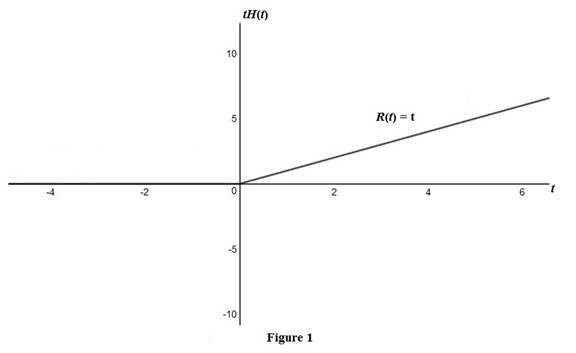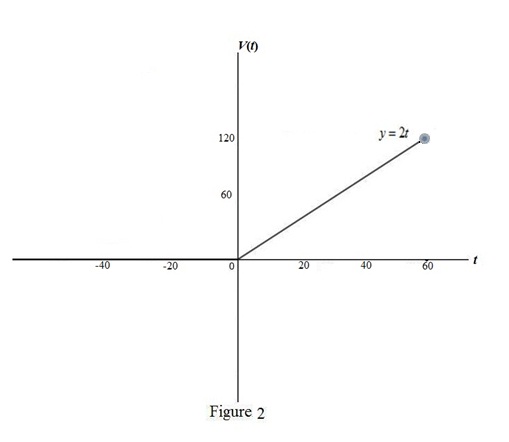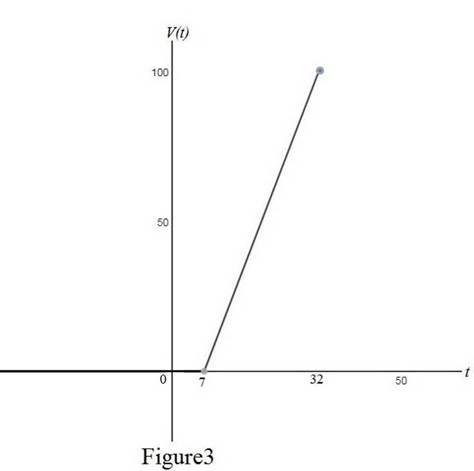
Concept explainers
The Heaviside function defined in Exercise 59 can also be used to define the ramp function y = ctH(t), which represents a gradual increase in voltage or current in a circuit.
(a) Sketch the graph of the ramp function y = tH(t).
(b) Sketch the graph of the voltage V(t) in a circuit if the switch is turned on at time t = 0 and the voltage is gradually increased to 120 volts over a 60-second time interval. Write a formula for V(t) in terms of H(t) for t ≤ 60.
(c) Sketch the graph of the voltage V(t) in a circuit if the switch is turned on at time t = 7 seconds and the voltage is gradually increased to 100 volts over a period of 25 seconds. Write a formula for V(t) in terms of H(t) for t ≤ 32.
(a)
To sketch: The graph of the ramp function
Explanation of Solution
Heaviside function is,
So, the ramp function is,
Use online graph calculator and draw the graph of the ramp function as shown below in Figure 1.

From Figure1, it is noted that the graph is a ray with starting point 0.
(b)
To sketch: The graph of circuit if the switch is turned at t = 0 and the voltage gradually increased to 120 volts in 60 seconds; write the formula for
Answer to Problem 58E
The formula for
Explanation of Solution
Given:
The voltage
Calculation:
Let the ramp function be
Find the value of c.
Since
It is known that
Therefore, equation(1) becomes,
Thus, the ramp function is
Therefore,
Use online graph calculator and draw the graph of

From Figure1, it is noted that the graph is a ray with starting point 0.
(c)
To sketch: The graph of the voltage in a circuit if the switch is turned at t = 7 seconds and gradually increased t0 100 volts over a period of 25 seconds; write the formula for
Answer to Problem 58E
The formula for
Explanation of Solution
The voltage varies from 0 to 100 in 25 seconds.
Therefore,
Therefore, the ramp function becomes,
The switch is turned at t = 7 seconds
That is, the time
Therefore, the formula for
Thus,
The function,
Use online graph calculator and draw the graph of

From Figure 3, it is noted that the voltage reaches to 100 in 25 seconds.
Chapter 1 Solutions
Single Variable Calculus: Concepts and Contexts, Enhanced Edition
 Calculus: Early TranscendentalsCalculusISBN:9781285741550Author:James StewartPublisher:Cengage Learning
Calculus: Early TranscendentalsCalculusISBN:9781285741550Author:James StewartPublisher:Cengage Learning Thomas' Calculus (14th Edition)CalculusISBN:9780134438986Author:Joel R. Hass, Christopher E. Heil, Maurice D. WeirPublisher:PEARSON
Thomas' Calculus (14th Edition)CalculusISBN:9780134438986Author:Joel R. Hass, Christopher E. Heil, Maurice D. WeirPublisher:PEARSON Calculus: Early Transcendentals (3rd Edition)CalculusISBN:9780134763644Author:William L. Briggs, Lyle Cochran, Bernard Gillett, Eric SchulzPublisher:PEARSON
Calculus: Early Transcendentals (3rd Edition)CalculusISBN:9780134763644Author:William L. Briggs, Lyle Cochran, Bernard Gillett, Eric SchulzPublisher:PEARSON Calculus: Early TranscendentalsCalculusISBN:9781319050740Author:Jon Rogawski, Colin Adams, Robert FranzosaPublisher:W. H. Freeman
Calculus: Early TranscendentalsCalculusISBN:9781319050740Author:Jon Rogawski, Colin Adams, Robert FranzosaPublisher:W. H. Freeman
 Calculus: Early Transcendental FunctionsCalculusISBN:9781337552516Author:Ron Larson, Bruce H. EdwardsPublisher:Cengage Learning
Calculus: Early Transcendental FunctionsCalculusISBN:9781337552516Author:Ron Larson, Bruce H. EdwardsPublisher:Cengage Learning





